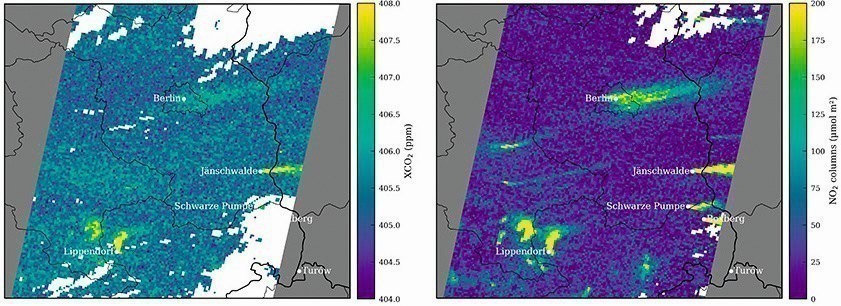CO2 concentrations in the air continue to rise rapidly and a rapid reduction in man-made emissions is becoming increasingly important. New satellites will determineCO2 emissions in the future.
Citiesare realCO2 guzzlers, but it is currently almost impossible to reliably determine how much is actually being emitted. Current estimates are based on statistics and activity data from transportation, industry, heating and energy generation. Evaluating this data is time-consuming and the results are only available after a long delay. The estimates are also uncertain, as precise figures are often not available and simplified assumptions have to be made - for example in the case of heating. Although the current monitoring network of ground stations is helpful in tracking the increase inCO2 in the atmosphere, it is currently not dense enough to provide reliable information on the emissions of individual countries or even individual cities.
For this reason, the EU is working with ESA to develop a system for monitoringCO2 emissions. A key component of this is theCO2M satellite mission: from 2025, the firstCO2M satellitesare to be sent into orbit, which will use spectroscopic measurements to create global maps of atmosphericCO2 concentrations. This will make it possible to determine where and how muchCO2 is emitted by industrial plants, cities and countries. These measurements would reduce the current uncertainties in estimatingCO2 emissions from the combustion of fossil fuels.
ESA is relying on Empa's expertise to equip the satellites with the appropriate measurement technology. "We were able to provide ESA with various recommendations for equipping the satellites," says Gerrit Kuhlmann from Empa's Air Pollution/Environmental Technology department. The difficulty in determiningCO2 emissions is to distinguish between anthropogenic and biological signals. The respiration of vegetation causes strong fluctuations in the distribution ofCO2. The satellite must therefore be able to separate these from man-made emissions. The idea: a combined measuring device that detectsCO2 as well as nitrogen dioxide (NO2). Because: "The combustion of coal, oil and gas not only producesCO2, but also nitrogen oxides. However, these are not produced during natural respiration in the biosphere," says
Kuhlmann. An additional NO2 instrument should therefore be able to filter out anthropogenicCO2 signals.
Empa simulates satellite measurements
 Satellite images from the Empa researchers' simulations: The image on the left shows the measurements from theCO2 instrument, the image on the right from the satellite's NO2 instrument. The emissions of the city of Berlin and several coal-fired power plants in the surrounding area are clearly visibleTotest this idea, Kuhlmann and his team simulated the distribution ofCO2 and NO2concentrations for the year 2015 with a spatial resolution never before achieved. The complex simulations were carried out on the fastest high-performance computer in Europe, the Piz Daint at the Swiss computing center CSCS in Lugano. They were able to show that a combination ofCO2 andNO2 measurements provides better and more reliable results than if only oneCO2 measuring device were installed on the satellite.
Satellite images from the Empa researchers' simulations: The image on the left shows the measurements from theCO2 instrument, the image on the right from the satellite's NO2 instrument. The emissions of the city of Berlin and several coal-fired power plants in the surrounding area are clearly visibleTotest this idea, Kuhlmann and his team simulated the distribution ofCO2 and NO2concentrations for the year 2015 with a spatial resolution never before achieved. The complex simulations were carried out on the fastest high-performance computer in Europe, the Piz Daint at the Swiss computing center CSCS in Lugano. They were able to show that a combination ofCO2 andNO2 measurements provides better and more reliable results than if only oneCO2 measuring device were installed on the satellite.
It is still unclear how many satellites need to be sent into orbit, but Kuhlmann recommends at least three. "The problem is that the sky is rarely cloud-free," says Kuhlmann. In 2015, the skies over Europe were free of clouds on just one day a week on average. The more satellites regularly record images, the higher the probability of seeing the exhaust plumes of individual sources such as cities and being able to determine the emissions from them. The recommendation to install an additionalNO2measuring instrument has already been incorporated into the planning of the new satellites.


